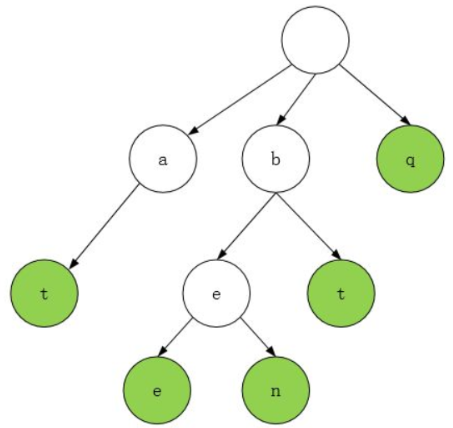题目描述
请设计一个数据结构,需要满足如下两种操作:
void addWord(word)
bool search(word)
search(word) 可以查找一个正则表达式,正则表达式只包含a-z和.,.可以匹配任意字母。
注意: 数据保证所有单词均只包含小写字母a-z。
样例
addWord("bad")
addWord("dad")
addWord("mad")
search("pad") -> false
search("bad") -> true
search(".ad") -> true
search("b..") -> true
算法
(trie树) $add: O(L), search: O(nL)$
我们可以用trie树来保存所有单词。
trie树也叫字典树,如下所示,该树中存储了
"at", "bee", "ben", "bt", "q"这几个单词。

因为插入的单词不包含通配符.,所以我们可以直接插入。
难点在于如何查找包含通配符的单词。我们可以用DFS搜索:
- 当遇到字母
a-z时,直接进入trie树节点对应的儿子; - 当遇到通配符
.时,枚举当前trie树节点的所有儿子;
时间复杂度分析:假设单词的平均长度是 $L$,总共有 $n$ 个单词。add操作会遍历 $L$ 个节点,所以时间复杂度是 $O(L)$;search操作最坏情况下会遍历所有节点,所以时间复杂度是 $O(nL)$。
C++ 代码
class WordDictionary {
public:
struct Node
{
bool is_end;
Node *next[26];
Node()
{
is_end = false;
for (int i = 0; i < 26; i ++ )
next[i] = 0;
}
};
Node *root;
/** Initialize your data structure here. */
WordDictionary() {
root = new Node();
}
/** Adds a word into the data structure. */
void addWord(string word) {
Node *p = root;
for (char c : word)
{
int son = c - 'a';
if (!p->next[son]) p->next[son] = new Node();
p = p->next[son];
}
p->is_end = true;
}
/** Returns if the word is in the data structure. A word could contain the dot character '.' to represent any one letter. */
bool search(string word) {
return dfs(word, 0, root);
}
bool dfs(string &word, int k, Node *u)
{
if (k == word.size()) return u->is_end;
if (word[k] != '.')
{
if (u->next[word[k] - 'a']) return dfs(word, k + 1, u->next[word[k] - 'a']);
}
else
{
for (int i = 0; i < 26; i ++ )
if (u->next[i])
{
if (dfs(word, k + 1, u->next[i])) return true;
}
}
return false;
}
};
/**
* Your WordDictionary object will be instantiated and called as such:
* WordDictionary obj = new WordDictionary();
* obj.addWord(word);
* bool param_2 = obj.search(word);
*/

